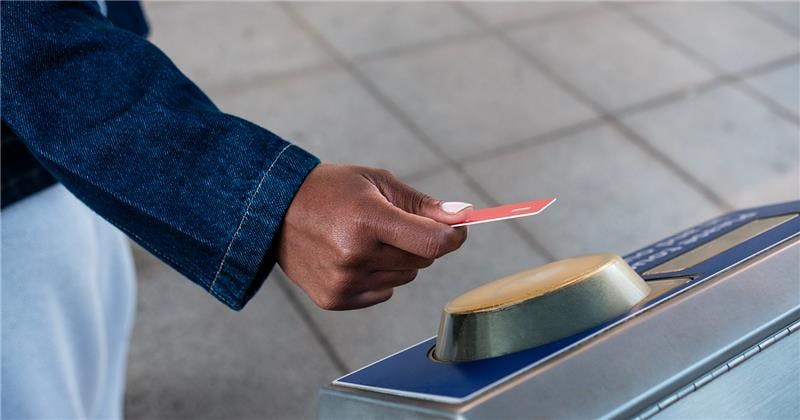What is an RFID chip? definition, function and everyday examples

RFID stands for Radio Frequency Identification. An RFID chip stores a small amount of data and transmits it wirelessly to a reader. You can find this technology in access cards, contactless payment cards, logistics labels, libraries, ski lift tickets, pet microchips and even in the e-passport.
The big advantage over a barcode: no line of sight is required and it is possible to read several tags simultaneously. Technically, a system consists of a tag with chip and antenna as well as a reader that requests and processes the data.
02.10.2025 | Reading time: 7 minutes
How exactly does an RFID chip work?
Active tags, on the other hand, have a battery. This allows for greater ranges or the integration of sensors, but they are more expensive and larger.
In most cases, an RFID chip only transmits a unique identifier (ID). The actual detailed information is stored in a database, which links the code to a record, for example customer data, ticket information or goods movements.
What frequencies and types are there?
RFID is used in three main areas, which differ in range, material compatibility and standards:
- LF (Low Frequency, approx. 125–134 kHz): short range of a few centimetres, very robust against liquids and metal, but with a low data rate. Typical for pet microchips and simple access systems.
- HF (High Frequency, 13.56 MHz): range up to about 10 cm, ideal for cards, tickets and libraries, compatible with standards such as ISO 14443 and ISO 15693.
- UHF (Ultra High Frequency, 860–960 MHz): range of several metres, ideal for logistics, inventories and asset tracking. Important standards include EPC Gen2 or ISO/IEC 18000-63.Each area has its own advantages and disadvantages: while LF is very reliable but slow, UHF systems enable fast processes – but only with careful antenna planning.
What is stored on a pet RFID chip?
Important: no personal data such as name or address is stored on the chip itself. The link is made in a registration database, which allows veterinarians or animal shelters to identify the correct owner. This way, data protection is maintained without compromising identifiability.
RFID in everyday life in Switzerland
- Payments: contactless cards use HF RFID and enable fast transactions at very short distances.
- Access: work and school cards open doors, often without direct line of sight.
- Leisure: ski tickets are worn under the jacket and are easily recognised through clothing.
- Libraries: multiple books can be checked in or out at the same time.
- Logistics: pallets, boxes and products can be tracked in real time.
- Travel documents: modern e-passports contain an RFID chip, combined with cryptography, to prevent unauthorised reading.
RFID and e-passports: how is data protected?
- BAC (Basic Access Control): only authorised readers with key data are allowed access.
- PACE (Password Authenticated Connection Establishment): modern variant with stronger encryption.
- EAC (Extended Access Control): protects particularly sensitive data such as fingerprints.
These procedures ensure that no data can be skimmed “in passing.”
RFID vs. NFC: what is the difference?
While classic RFID tags are usually read passively by a reader, NFC also enables peer-to-peer communication and the emulation of cards via smartphones.
Simply put: every NFC is RFID, but not every RFID is NFC.
How much data can an RFID chip hold?
There are also memory tags with additional fields, for example for serial numbers, batches or checksums. For more complex amounts of data, however, linking to a database is far more efficient – especially in logistics, where inexpensive UHF tags are used in large quantities
Advantages and limitations of RFID
The limitations: HF and LF are restricted to short ranges. UHF allows several metres, but is prone to interference from liquids and metals. In addition, security does not come from technology alone, but from processes. Tags are only one component; control lies in the systems behind them.
Data protection and security
Payment cards are designed with their short range and protocol security so that accidental skimming in everyday life is highly unlikely. Where sensitive data is stored, protective sleeves or consciously careful handling can help.
Important: in many scenarios, only an anonymous ID is stored on the tag – without the corresponding database, no personal reference is possible.
RFID as an invisible helper in everyday life
To keep the technology secure, in addition to the chips, standards, encryption and responsible processes are also required. Those who understand how frequencies, types and security mechanisms interact can take advantage of RFID without overlooking the risks.
FAQ about RFID
What is an RFID chip in one sentence?
What is the range of RFID?
What is stored on a pet chip?
Is NFC the same as RFID?
Which standards are important?
- HF cards: ISO 14443, ISO 15693
- UHF: EPC Gen2, ISO/IEC 18000-63
- Pet chips: ISO 11784/11785
